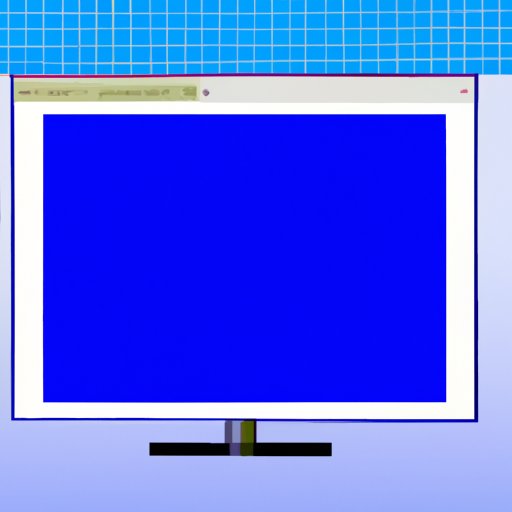I. Introduction
Knowing how to capture a screenshot on your computer can be a valuable skill, whether you’re trying to save an important moment, share information with a colleague, or troubleshoot an issue. However, many people face common challenges when trying to take a screenshot on Windows or Mac computers. In this article, we will walk you through the step-by-step process of taking a screenshot on your computer, share tips and tricks to capture high-quality screenshots, highlight essential tools and shortcuts, and offer advanced techniques for power users.
II. A Step-by-Step Guide to Taking a Screenshot on Your Windows Computer
Windows offers several ways to capture a screenshot, depending on your computer and operating system. You can use the Print Screen (PrtScn) key, Snipping Tool, or the Windows Game Bar to take screenshots. Here’s how:
- To capture a full-screen screenshot, press the Print Screen key on your keyboard.
- To capture a selected area, press Windows + Shift + S to open the Snipping Tool. Click and drag the cursor to select the area you want to capture, and then save the screenshot.
- If you’re using Windows 10, you can also use the Windows Game Bar to take screenshots during gaming or other activities. Press Windows + G to open the Game Bar, and click on the camera icon to take a screenshot.
When taking a screenshot on Windows, it’s important to note that the screenshot is saved to the clipboard by default, and you will need to paste it into an image editing program to save it or make further edits.
III. How to Screenshot on a Mac: A Beginner’s Guide
Mac computers offer similar options for capturing a screenshot, but the process may vary slightly depending on the version of macOS you’re running. Here are the most common ways to take a screenshot on a Mac:
- To capture the entire screen, press Command + Shift + 3.
- To capture a selected area, press Command + Shift + 4, drag the cursor to select the area you want to capture, and release the mouse button.
- If you want to capture a specific window, press Command + Shift + 4, then press the spacebar. The cursor will change to a camera icon, and you can click on the window you want to capture.
Like Windows, after taking a screenshot on a Mac, it’s saved to the desktop as a PNG file. There are also additional options like saving it to the clipboard, previewing the screenshot, or sharing it directly from the preview window.
IV. Capturing Screenshots on Your Computer: Tips and Tricks
While taking a screenshot may seem simple, there are several best practices you can follow to save time, avoid mistakes, and capture high-quality images. Here are some tips:
- Use the right shortcut or tool for the job.
- Check your settings to ensure the screenshot is in the right format or saved to the correct location.
- Experiment with the different screenshot options to find the one that works best for you.
In addition, there are a few common mistakes you should avoid when taking screenshots, such as neglecting to hide your desktop or apps, taking low-resolution images, or not editing the screenshot after capturing it. If you do encounter any issues or errors while taking screenshots, try troubleshooting them by checking your settings, updating your drivers or software, or restarting your computer.
V. Screenshotting on Your Computer: The Tools and Shortcuts You Need to Know
To take screenshots more efficiently, you can also use essential tools and shortcuts that are built into your computer or available through third-party software. Here are the ones you should know:
- Print Screen (PrtScn) or Command + Shift + 3: Capture a full-screen screenshot.
- Windows + Shift + S or Command + Shift + 4: Capture a selected area.
- Alt + Print Screen or Command + Shift + 4, then press spacebar: Capture a specific window.
- Snipping Tool or Snip & Sketch: Capture and annotate screenshots on Windows.
- Grab or Screenshot: Capture and annotate screenshots on Mac.
- Third-party tools or browser extensions like Lightshot or Nimbus Screenshot: Provides additional editing and annotation features.
VI. Advanced Screenshotting Techniques for Power Users
If you want to take your screenshotting skills to the next level, you can also explore some advanced techniques used by power users. These include:
- Capturing scrolling screenshots or webpage screenshots using tools like Snagit or OneNote.
- Using third-party screenshot software like Greenshot, PicPick, or ShareX to access additional features like OCR, screen recording, or cloud storage.
VII. How to Edit and Annotate Your Screenshots on Your Computer
Finally, after capturing your screenshots, you may want to edit or annotate them to make them more visually appealing or easier to read. There are several built-in editing tools on both Windows and Mac, including the Snipping Tool, Snip & Sketch, Preview or screen capture office on Mac, that allow you to crop, resize, add text, or highlight important details. You can also use third-party image editing software like Adobe Photoshop, GIMP, or Inkscape to take your edits to the next level.
VIII. Conclusion
In conclusion, taking a screenshot on your computer can be a quick and easy way to capture important information, share ideas, and troubleshoot issues. By following the step-by-step guide we have provided, you should now be able to take screenshots on both Windows and Mac computers with ease. Remember to use the right tools and shortcuts, follow best practices for capturing high-quality images, and take advantage of advanced techniques or editing tools. Whether you’re a casual user or a power user, capturing and editing screenshots can be a valuable skill that can save you time and enhance your productivity.
